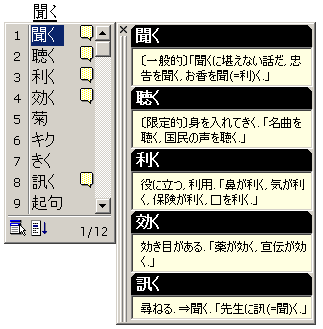I think I learned 「別に」 probably around the same time I learned how to say “yes” and “no” in Japanese. That’s how awesome and useful this expression is. Unfortunately, it’s not the type of thing that’s taught in a classroom so I’m putting this one in the “Colloquialism” category, which is just my way of saying, “I take no responsibility for what you do with this stuff.”
Don’t get me wrong. 「別」 is an incredibly useful character and is used in a variety of perfectly legitimate words. I would definitely put it in the top 100 kanji list. For instance, 「別れる」 means to “breakup” or “to part from”, a word just as useful but not as harsh as 「振られる」, which means you were dumped or more literally, “shaken off” (ouch). Or just repeat the same character and you have 「別々」, which is essential for when you don’t want to pay for everybody else’s meal. (“Going Dutch” is, unlike Korea and China, customary and quite common in Japan.) And finally, we have 「別に」, the topic of today’s post.
Don’t try this at class
「別に」 is an expression that is very similar to 「微妙」, in many ways. It has a perfectly normal and standard usage but it can also be considered slang, if you use it a certain way.
A lot of people learning Japanese at school have probably already learned 「特に」, which means “especially” or “particularly”. It’s an useful expression particularly because you can use it with the negative to express a lack of preference.
A) なんか食べたい物ある?
– Is there anything you want to eat?B) 特にないけど・・・
– Not particularly.
Now, that’s all fine and good but what if we wanted to express a lack of preference for positive answers, for instance, like the following dialogue?
A) Can I borrow this?
B) Whatever, sure.
In Japanese, when somebody asks you if something is ok to do, you normally respond with 「いいよ」 (or いいですよ). But 「特にいい」 doesn’t really work here, because it is not a negative response and you end up with, “It’s particularly good”. That doesn’t make much sense. So how do we translate the, “whatever” into Japanese? Well, why don’t we take a look at the following dialogue?
A) これ、借りていい?
– Can I borrow this?B) 別にいいよ。
– Whatever, sure.
「別に」 actually means “apart from” but you don’t really need to include from what exactly. So you can use it in place of 「特に」 such as the first dialogue to say pretty much the same thing.
A) なんか食べたい物ある?
– Is there anything you want to eat?B) 別にないけど・・・
– Nothing really.
The “nothing really” is a loose translation but it reflects the fact that you are literally saying, “nothing, apart from” and being vague about what exactly is separate.
If you were wondering how to express your apathetic, non-caring, and sketchy personality, 「別に」 is just the ticket.
A) 本当に行かなくてもいいの?
– Is it really ok to not go?B) 別に行かなくてもいいよ。
– Whatever, I don’t have to go.
A) チョコが好き?
– Do you like chocolate?B) 別に。
– Whatever.
Conclusion
So next time somebody is badgering you with questions, you can just reply with 「別に」. Make sure you say it with plenty of spit and a look of complete contempt while you’re at it. It’ll be like you’re saying, “Uh uh, whatever“, all shaking your head, with one hand on your hip and the other waving a index finger at your victim.
Oh wait, was this the part where I was supposed tell you not to do that?

